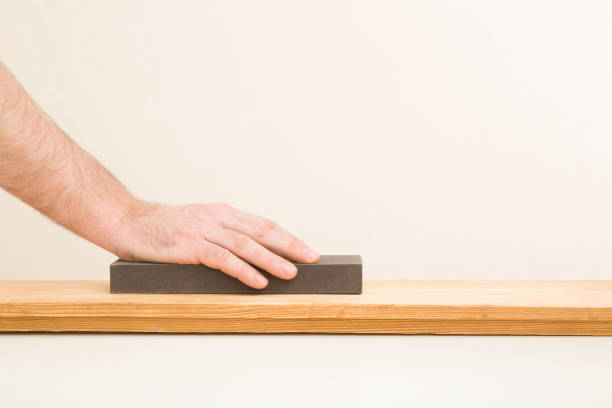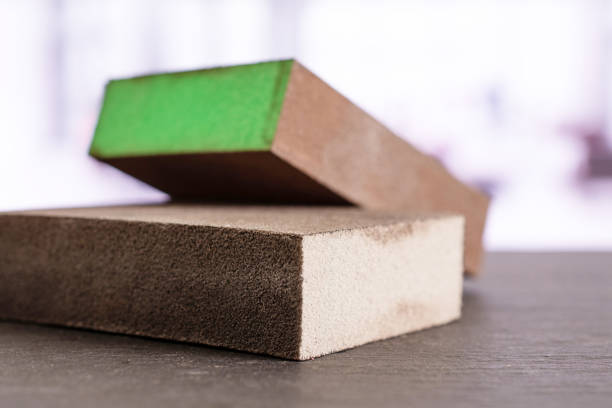Sanding, a common task in carpentry, has evolved over the years with the advent of various tools and techniques. One such tool, the sanding sponge, has caught the attention of craftsmen for its unique properties and benefits. This comprehensive guide aims to shed light on everything you need to know about sanding sponges, their uses, pros and cons, and how they compare to traditional sanding blocks and sandpaper.
Understanding Sanding Sponges
Sanding sponges are innovative tools that offer a fresh perspective on sanding. They are essentially spongy blocks with abrasive surfaces, used for sanding wood, drywall, and plastic. The abrasive material, akin to sandpaper, is adhered directly to the sponge’s foam, making it a hybrid of a sanding block and sandpaper.
The Evolution of Sanding Tools
Sanding sponges have their roots in traditional sanding tools. Hand sanding with a sheet of sandpaper is a time-honored technique, but it can be taxing on the hands. To combat fatigue, craftsmen developed the sanding block, a base to which sandpaper is attached, providing even pressure and a comfortable grip.
A sanding sponge combines the benefits of the sanding block and sandpaper, offering a comfortable grip, even pressure, and a durable abrasive surface. However, it’s important to note that sanding sponges are not a direct replacement for either tool.

Types of Sanding Sponges
Sanding sponges come in various types, each designed for specific sanding tasks. The three primary types include:
- Variable Grit Sanding Sponges
- Dust Channeling Sanding Sponges
- Corner Sanding Sponges
Variable Grit Sanding Sponges
Variable grit sanding sponges are the most common type. They come in different grits, similar to sandpaper. The grit number indicates the coarseness of the abrasive surface – the lower the number, the coarser the grit. Coarser grits remove more material, while finer grits provide a smoother finish.
Variable grit sanding sponges also come in different sizes. Larger sponges are ideal for extensive applications, like smoothing drywall or preparing furniture for paint. On the other hand, smaller sponges are perfect for detailed work on small crafts.
Dust Channeling Sanding Sponges
Dust channeling sanding sponges are designed to tackle dust build-up during sanding. Traditional sandpaper can get clogged with dust, reducing its effectiveness. Dust channeling sponges feature special channels that collect dust, preventing clogging and improving sanding efficiency. Although they may cost a little more, their increased efficiency might make up for the extra cost.
Corner Sanding Sponges
Corner sanding sponges are designed with a beveled edge, enabling you to sand in tight spaces. Whether you’re sanding grooves on trim or tight corners, these beveled sponges can exert pressure in tight spaces, making them an invaluable tool for detailed work.
Advantages of Using a Sanding Sponge

Sanding sponges offer numerous benefits that make them a worthy addition to any tool kit. Here are some key advantages:
- Comfort: Sanding sponges are easy to grip and less tiring to use than traditional sandpaper or power sanders.
- Efficiency: The increased grip, decreased clogging, and even pressure of sanding sponges can reduce sanding time.
- Versatility: The spongy nature of these tools allows them to conform to the shape of the object being sanded, making them ideal for rounded edges.
- Durability: Sanding sponges are resistant to damage. Even when worn out, they can still serve as a grip for regular sandpaper.
While sanding sponges offer these advantages, they also have some drawbacks.
Drawbacks of Using a Sanding Sponge
Despite their benefits, sanding sponges have some limitations:
- Limited Versatility: Although versatile in their own right, they lack the adaptability of regular sandpaper, which can be used in many ways, including with power sanders.
- Cost: Sanding sponges are more expensive than regular sandpaper. While a pack of sandpaper can be bought for the price of a single sanding sponge, the longevity and comfort of the latter might justify the cost.
- Limited Grit Options: To access different grits, you need to purchase multiple sponges, which can add to the cost. However, dual-grit sponges with different grits on each side are available.
How to Use a Sanding Sponge

Using a sanding sponge requires some guidelines to ensure safety and effectiveness:
- Safety First: Always wear eye protection and a face mask to avoid inhaling dust.
- Start Coarse: Begin with a coarse grit to remove more material and gradually move to finer grits for a smoother finish.
- Sand with the Grain: To avoid scratch marks and achieve a smooth finish, always sand in the direction of the grain.
- Apply Even Pressure: Let the sandpaper do the work. Applying excessive pressure can cause scratches and fatigue.
In conclusion, sanding sponges are a great addition to any craftsman’s toolkit. They offer comfort, control, and efficiency, making sanding tasks less tedious and more productive. Whether you’re a professional carpenter or a DIY enthusiast, understanding the use and benefits of sanding sponges can help you make the most of your sanding tasks.

